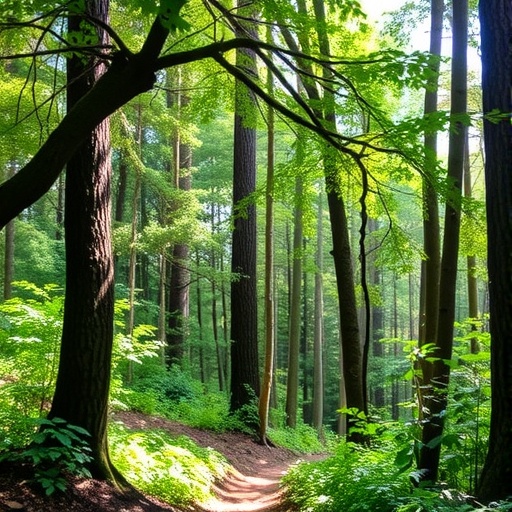In the dense and often mystifying landscapes of the Central Himalaya, a significant ecological exploration is unraveling the intricate dance of life within Sal forests, predominantly composed of the Sal tree, scientifically known as Shorea robusta. The comprehensive research conducted by N. Joshi and N. Joshi unveils a critical examination of the species composition, vegetation structure, and ecological diversity shaped by various management systems. This groundbreaking study, expected to be published in Discoveries in Forestry, adds an essential chapter to our understanding of forest ecology in one of the world’s most sensitive and biodiverse regions.
The Central Himalaya represents a unique convergence of climatic and geological factors that influence its rich biodiversity. The Sal forests, in particular, serve as a habitat for a plethora of species, supporting an intricate web of life. Through diligent fieldwork and meticulous data collection, researchers have sought to document the various plant species that coexist alongside Shorea robusta, illuminating the diverse flora and fauna characteristic of these forests. Their findings emphasize the ecological significance of maintaining biodiversity, as it not only supports wildlife but also contributes to overall forest health and resilience.
One of the core aspects of the research is the exploration of management practices that have shaped these forests over time. The utilization of diverse management systems has revealed varying impacts on the ecological state of the forests. Through a comparative analysis, the researchers have illuminated how different approaches to forest management can lead to distinct outcomes in terms of species richness and vegetation structure. This aspect of the study offers crucial insights for policymakers and forestry officials, who play a vital role in shaping the future of these forests.
The research highlights the necessity of sustainable management practices that harmonize human needs with ecological integrity. As pressures from logging, agriculture, and urban development continue to escalate in the region, understanding how to balance conservation with economic needs becomes increasingly paramount. The findings suggest that adaptive management strategies—those that are responsive to ecological feedback—can foster healthier forests and a more sustainable relationship between humans and nature.
Additionally, the study captures the profound connection between vegetation structure and ecosystem services. Sal forests are known to contribute significantly to carbon sequestration, soil health, and water regulation. By analyzing the vegetation structure, the researchers underscore how diverse plant communities enhance these ecosystem services, thereby reinforcing the argument for preserving biodiversity. The implications of their findings reach far beyond the academic sphere, influencing practical conservation efforts and community awareness.
Furthermore, the researchers utilized advanced methodologies, blending traditional ecological surveys with modern statistical techniques. This innovative approach not only enhances the accuracy of species identification but also allows for a more nuanced understanding of ecological interactions within these forests. The incorporation of such methodologies serves as a template for future ecological studies, particularly in biodiversity hotspots where data scarcity can impede progress.
The ongoing climate crisis underscores the urgency of research such as this. As the effects of climate change become increasingly pronounced, the resilience of forest ecosystems is tested. The study by Joshi et al. illuminates the potential of diverse ecosystems to withstand climatic variations, emphasizing the importance of maintaining genetic and species diversity to bolster forest resilience. By fostering healthier tree populations, the forests can adapt better to climatic stresses, ensuring their survival for generations to come.
In exploring the distribution patterns of various species within the Sal forests, the research identifies key drivers influencing biodiversity. Factors such as soil composition, topography, and microclimatic conditions play critical roles in shaping the plant communities present. The researchers advocate for a more nuanced understanding of these ecological underpinnings, which will aid in developing targeted conservation strategies that preserve both rare and common species.
The intricate dynamics at play within Sal forests not only highlight their ecological importance but also their cultural significance. For local communities, these forests are not just a source of timber but hold cultural and spiritual value. The study emphasizes the need to integrate local knowledge and values into forest management practices, fostering a sense of stewardship among communities who rely on these ecosystems for their livelihoods.
Moreover, as discussions around deforestation and forest degradation continue to gain traction globally, this research contributes vital knowledge to the discourse. The findings reveal that well-managed Sal forests can serve as a model for sustainable forestry practices in other regions facing similar challenges. By illustrating the benefits of responsible management, the researchers hope to inspire a global shift towards greater ecological awareness and action.
In conclusion, the comprehensive study conducted by Joshi and Joshi on the Sal forests of the Central Himalaya serves as a beacon of hope for biodiversity conservation. By shedding light on the species composition, vegetation structure, and the impacts of management systems, this research not only enriches our understanding of these vital ecosystems but also calls for immediate action to ensure their sustainability in the face of mounting environmental pressures. The outcomes inspire a renewed commitment to ecological stewardship—a necessary step as we navigate the intertwined futures of humanity and nature.
The challenges presented in these findings should galvanize both local and global communities, encouraging collaboration among scientists, policymakers, and local populations to foster healthier forest ecosystems. This rich tapestry of life, culture, and ecological balance necessitates concerted efforts to secure a future where both nature and society can thrive in harmony.
Subject of Research: Species composition, vegetation structure, and diversity of Sal (Shorea robusta) forests.
Article Title: Species composition, vegetation structure and diversity of Sal (Shorea robusta) forests across different management systems in Central Himalaya, India.
Article References:
Joshi, N., Joshi, N. Species composition, vegetation structure and diversity of Sal (Shorea robusta Gaertn.) forests across different management systems in Central Himalaya, India.
Discov. For. 1, 38 (2025). https://doi.org/10.1007/s44415-025-00042-z
Image Credits: AI Generated
DOI:
Keywords: Shorea robusta, Sal forests, biodiversity, vegetation structure, forest management, Central Himalaya.




